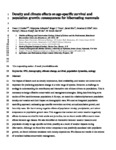Density and climate effects on age‐specific survival and population growth: consequences for hibernating mammals
| dc.contributor.author | Combe, FJ | |
| dc.contributor.author | Juškaitis, R | |
| dc.contributor.author | Trout, RC | |
| dc.contributor.author | Bird, S | |
| dc.contributor.author | Ellis, Jonathan | |
| dc.contributor.author | Norrey, J | |
| dc.contributor.author | Al‐Fulaij, N | |
| dc.contributor.author | White, I | |
| dc.contributor.author | Harris, WE | |
| dc.date.accessioned | 2023-02-13T14:33:46Z | |
| dc.date.available | 2023-02-13T14:33:46Z | |
| dc.date.issued | 2022-12-22 | |
| dc.identifier.issn | 1367-9430 | |
| dc.identifier.issn | 1469-1795 | |
| dc.identifier.uri | http://hdl.handle.net/10026.1/20302 | |
| dc.description.abstract |
The impact of factors such as density dependence, food availability and weather are known to be important for predicting population change in a wide range of species. However, a challenge in ecology is understanding the contributory and interactive role of these drivers on populations. This is necessary to design effective conservation and management strategies. Using data from long-term studies of five hazel dormouse Muscardinus avellanarius populations in Europe, we tested the relationship between population density and weather and their impact on demographic rates. We used an integrated population modelling approach, estimating age-specific overwinter survival, annual population growth and fecundity rates. We found strong negative effects of population density, precipitation and winter temperature on population growth rates. This suggests that warmer and wetter weather negatively affects dormouse survival for both adults and juveniles, but we found subtle differences in these effects between age classes. We also identified an interaction between weather measures and population density on age-specific survival, possibly as a result of weather impacts during hibernation. Although we found low winter temperature was positively associated with population growth, we found evidence consistent with density dependence. We discuss our results in the context of woodland habitat conservation management. | |
| dc.format.extent | 317-330 | |
| dc.language | en | |
| dc.language.iso | en | |
| dc.publisher | Wiley | |
| dc.rights | Attribution-NonCommercial-NoDerivatives 4.0 International | |
| dc.rights.uri | http://creativecommons.org/licenses/by-nc-nd/4.0/ | |
| dc.title | Density and climate effects on age‐specific survival and population growth: consequences for hibernating mammals | |
| dc.type | journal-article | |
| dc.type | Journal Article | |
| plymouth.issue | 3 | |
| plymouth.volume | 26 | |
| plymouth.publication-status | Published | |
| plymouth.journal | Animal Conservation | |
| dc.identifier.doi | 10.1111/acv.12843 | |
| plymouth.organisational-group | /Plymouth | |
| plymouth.organisational-group | /Plymouth/Faculty of Science and Engineering | |
| plymouth.organisational-group | /Plymouth/Faculty of Science and Engineering/School of Biological and Marine Sciences | |
| plymouth.organisational-group | /Plymouth/REF 2021 Researchers by UoA | |
| plymouth.organisational-group | /Plymouth/REF 2021 Researchers by UoA/UoA06 Agriculture, Veterinary and Food Science | |
| plymouth.organisational-group | /Plymouth/Users by role | |
| plymouth.organisational-group | /Plymouth/Users by role/Academics | |
| dcterms.dateAccepted | 2022-11-21 | |
| dc.rights.embargodate | 2023-12-22 | |
| dc.identifier.eissn | 1469-1795 | |
| dc.rights.embargoperiod | Not known | |
| rioxxterms.versionofrecord | 10.1111/acv.12843 | |
| rioxxterms.licenseref.uri | http://creativecommons.org/licenses/by-nc-nd/4.0/ | |
| rioxxterms.type | Journal Article/Review |



